When I write my weekly Yard Post I’m often sitting in my garage, where my view out of the door used to be a weedy hillside but is now this: a dedicated Bee Garden full of color.
The notion to grow a Bee Garden has been germinating for years, and finally last winter I went for it.
What is a Bee Garden, exactly? Why did I plant mine? (Surprise: it’s related to avocados!) What did it take to get it growing? What did I do right and wrong in the process? And what value — besides the colors — has it brought to my yard?
What is a Bee Garden?
A Bee Garden is an area planted with flowers that bees love to feed on — they drink the flowers’ nectar and gather the pollen. It’s not just a garden of random flowers because some flowers are useless to bees. And it’s not meant to only feed honey bees. I want to support native bees as well, of which there are many, of all shapes and sizes, and colors.
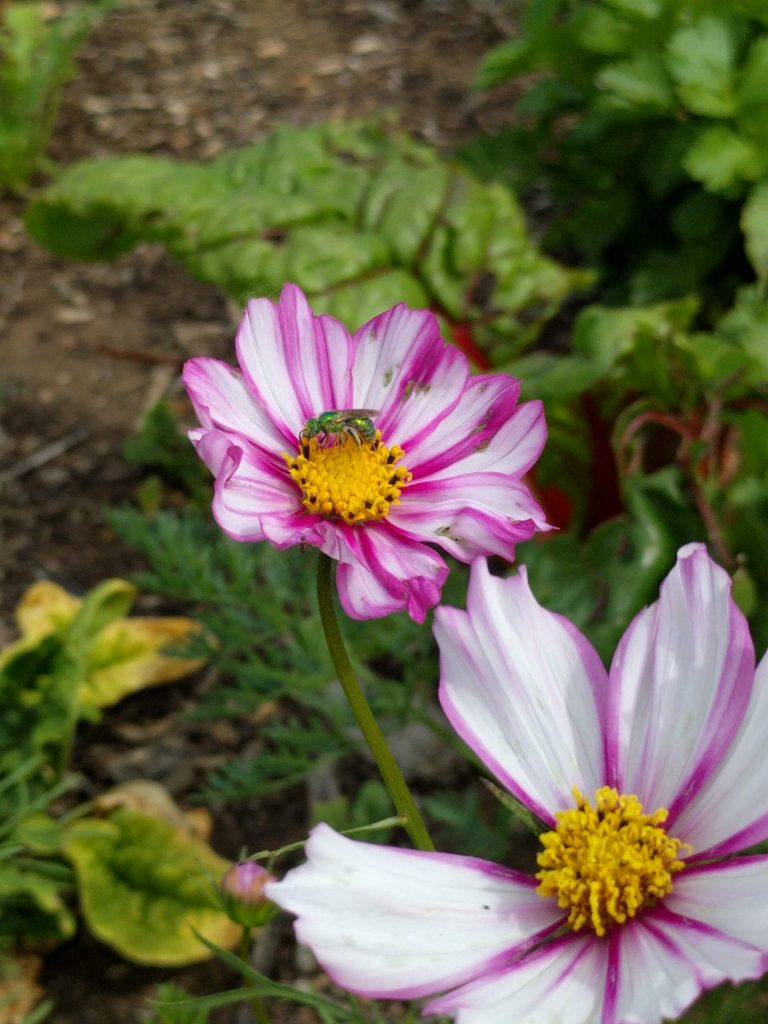
In fact, my Bee Garden should be called a Pollinator Patch because my interests aren’t even restricted to supporting bees but include wasps, flies, butterflies, hummingbirds, moths, beetles, and every other pollinator. But I like the name Bee Garden better, so I’ve stuck with that.
Why did I plant a Bee Garden?
Why dedicate a part of my yard to feeding bees (and the like)? Though I am inclined to conservation — and much bee habitat has been reduced with the expansion of agriculture and cities across California — and I’m a bit of a wannabe naturalist — trying to attract and identify some of the 1,400 native bees of California is an enticing challenge — what mainly inspired me to plant a Bee Garden was the desire for bees’ pollination services.
When greater numbers of bees visit the flowers of your fruit trees and vegetables, you are going to get greater quantities of fruits and vegetables. I feed them, and I expect that they will feed my family.
More specifically, I hoped to get more avocados. This wasn’t a baseless hope. Bee and avocado experts in California have also lately been growing large Bee Gardens near commercial groves with the same hope. (Read more about that here.)
More to the point, for years I had been growing small patches of flowers that are attractive to bees near some of my avocado trees, and I had seen that they beckoned various bees and also seemed to increase bee visits to the flowers of the adjacent avocado trees. (See my post “Oh, the mistakes I’ve made: Thinking flowers were for girls.” In it there is a video showing bees on flowers near some avocados last year.)
So with my new, full-sized Bee Garden, I was merely scaling up a proven concept. What I didn’t anticipate were the other benefits that the Bee Garden has brought to my yard beyond the pollination services that I was mainly after — a pretty view from the garage door being but one.
How did I plant the Bee Garden?
In the fall, I gathered and purchased the appropriate seeds, cleared the area’s weeds, and eagerly anticipated the season’s first rain. On December 4, I saw that rain was forecast for the following day so I sprinkled the seeds and raked them in. Over the next two days, 1.62 inches fell and a couple weeks later the first poppies emerged.
In addition to poppies, I had also sowed cilantro seeds that I’d saved from my own plants that I’d grown in other patches near avocado trees. What I like about poppies and cilantro are that bees love them and they can be grown without any irrigation in Southern California. Sow the seeds during winter rains and you’ve got flowers a couple months later, absolutely. It has worked in the wet years and the driest of dry years.
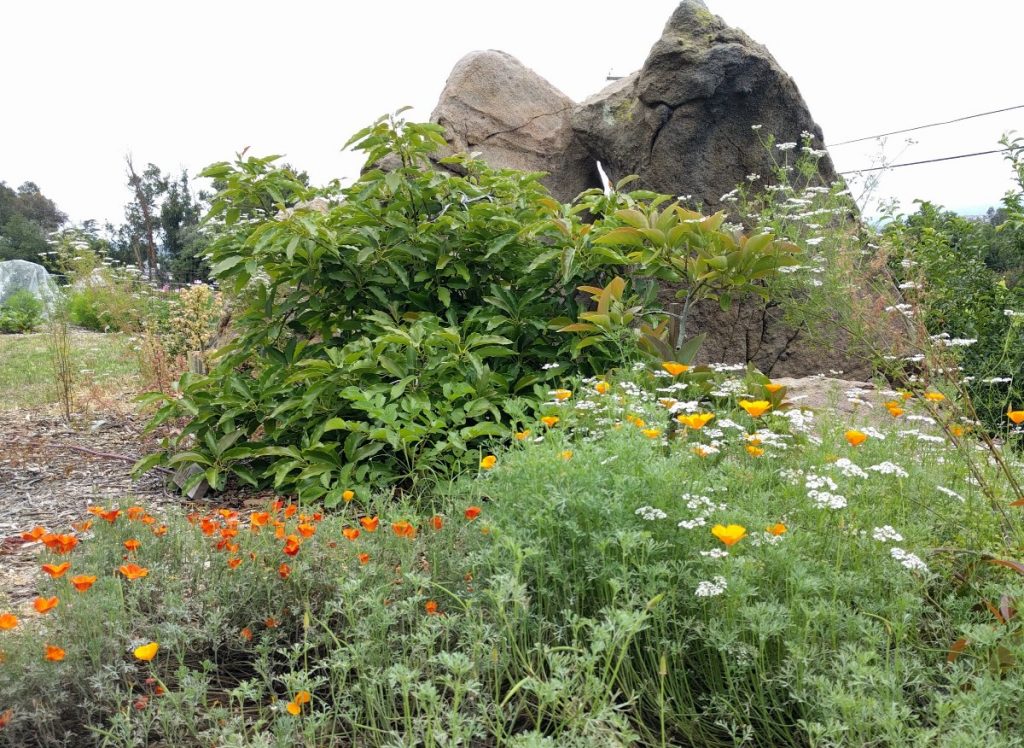
But I wanted my Bee Garden to last beyond the bloom period of poppies and cilantro, which is winding down now, at the end of spring. So I added seeds from a company called Botanical Interests, the packet of seeds being called “Save the Bees.”
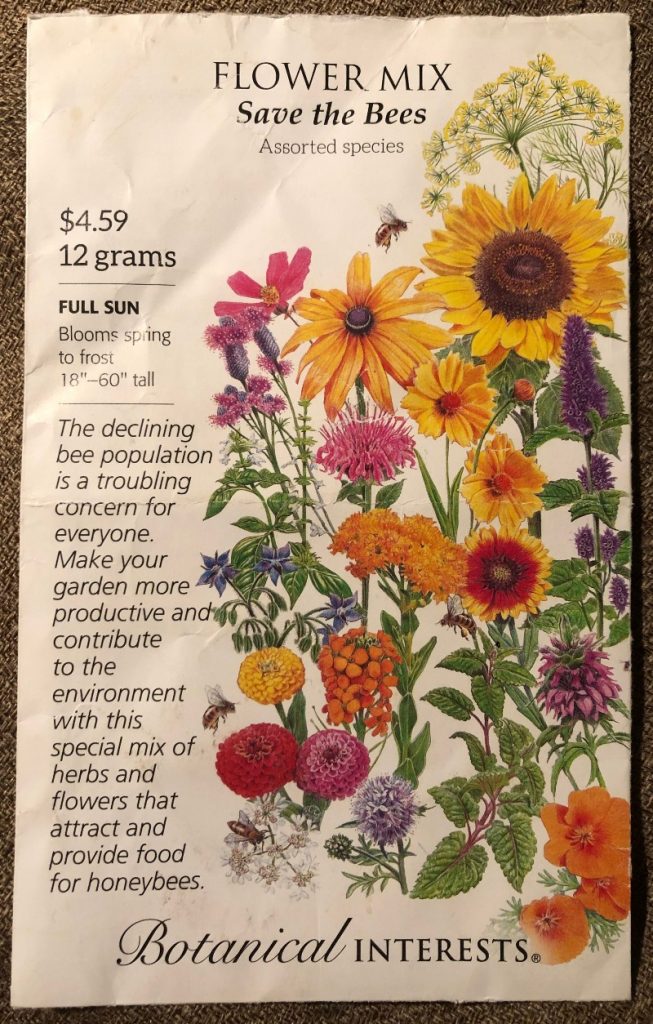
Inside Save the Bees are seeds of 19 flowering plants, each of which blooms in a slightly different season. So along with my cilantro and poppies (which, incidentally, are also included in the Save the Bees mix), a few other plants germinated and started blooming in late winter and early spring, and here at the end of spring new species are opening their first flowers.
Follow the Bee Garden’s growth and development from winter into spring and up to here in early June:
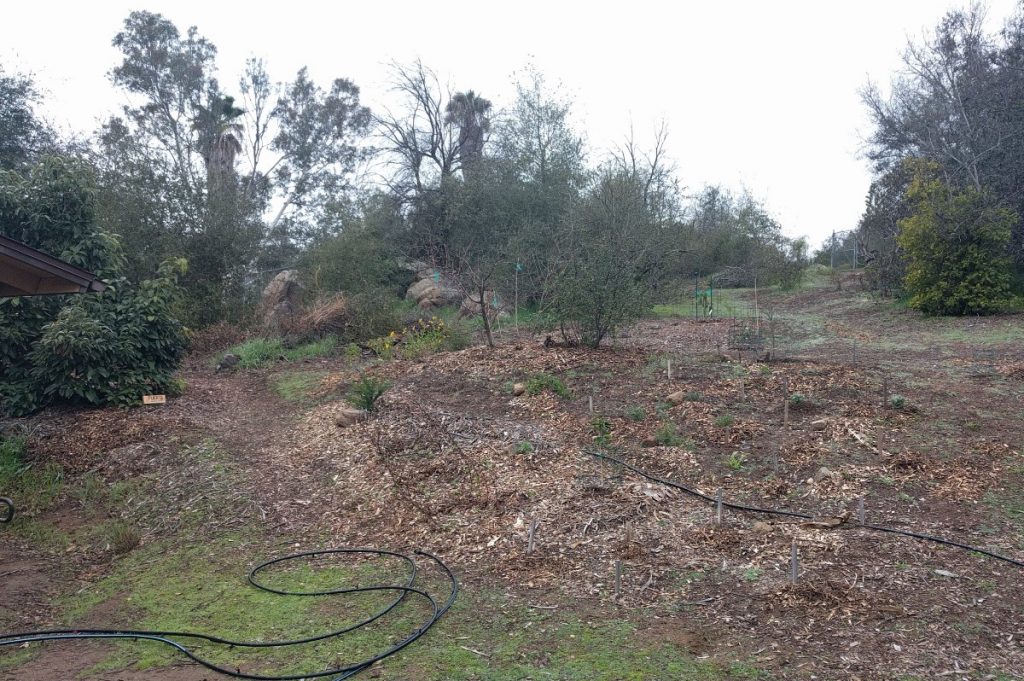
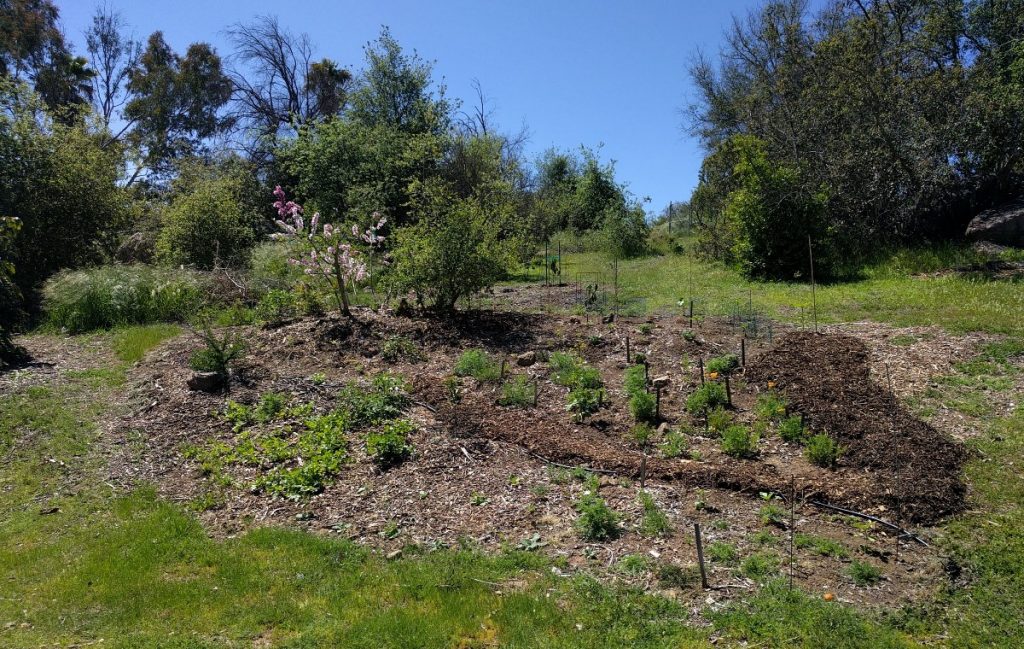

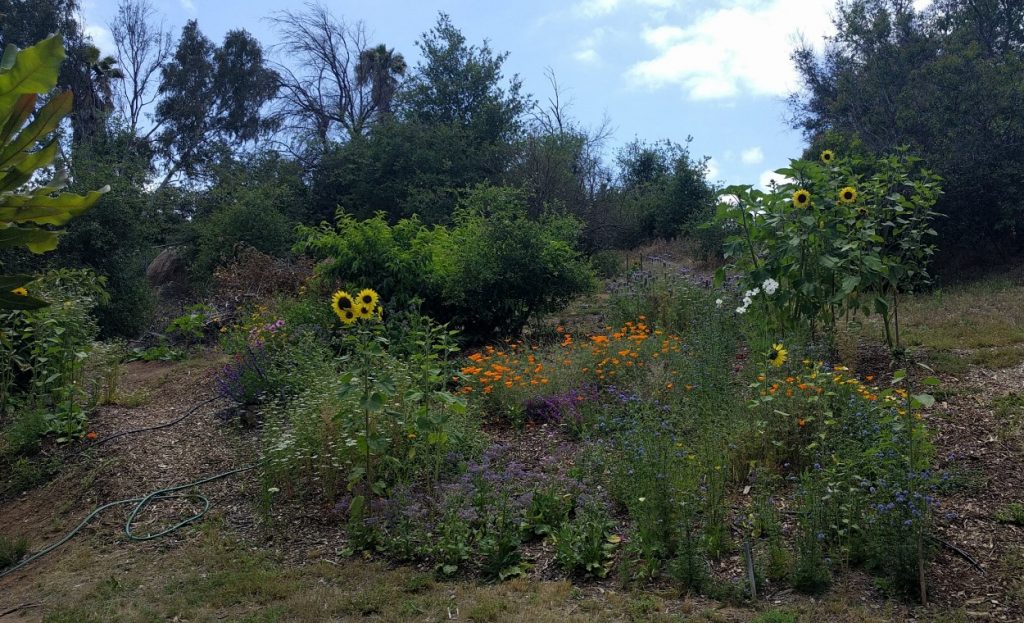
Sow in trays too
It turned out, however, that directly sowing the seeds was not the best method. Over the next month or so, plants would emerge only to often be eaten by bugs or birds or rabbits. Luckily, I had also sowed some seeds in trays at the same time. The Bee Garden as it blooms today is partly composed of plants that I later transplanted from the trays.
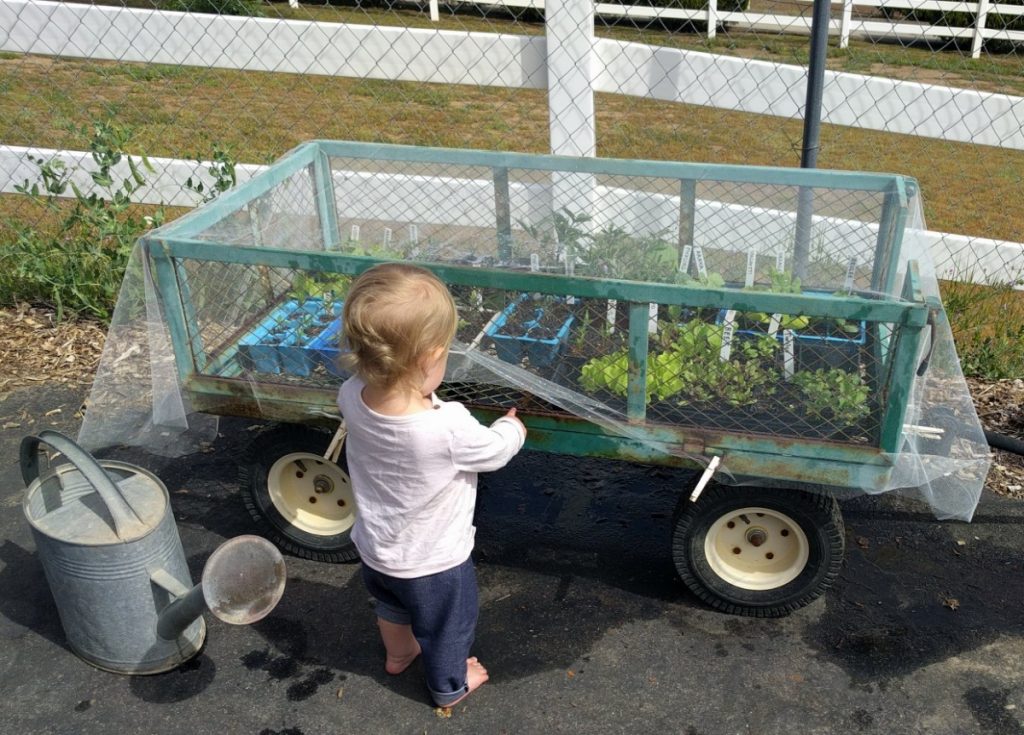
Annuals and perennials
I sowed all of these flower seeds because I wanted to draw bees this year, as soon as possible, but I have long term goals for the Bee Garden that required me to buy some plants that will live for many years. In the future, I want the Bee Garden to be a smorgasbord for bees while needing little attention from me. That means plant perennials also, and especially natives.
I planted ceanothus, buckwheat, lavendar, rosemary, penstemon, and encelia, most of which you can’t see in zoomed out photos because the annual flowers that I seeded have grown so fast and tall over them. But they’re there. And I envision them becoming the backbone of the Bee Garden over time.
Choosing plants
I chose my perennial/native plants and the seeds I sowed based on my own past observations and on the recommendations of Gordon Frankie. Frankie is a bee expert at U.C. Berkeley and the lead author of the excellent book California Bees and Blooms (see it on Amazon here), which I highly recommend (my review of the book is here).
In California Bees and Blooms, eleven rules of thumb are given to help establish a Bee Garden that attracts a diversity of bees throughout much of the year. Related to choosing plants, one rule of thumb advises to include plants that flower at different times of the year so there is always something for the bees to eat.
I followed this advice. My perennials will bloom in different parts of the year, as will the various plants in the Save the Bees mix. For example, globe gilia were in full bloom a month ago but now borage is, and just beginning to flower are gaillardia and sunflowers and cosmos.

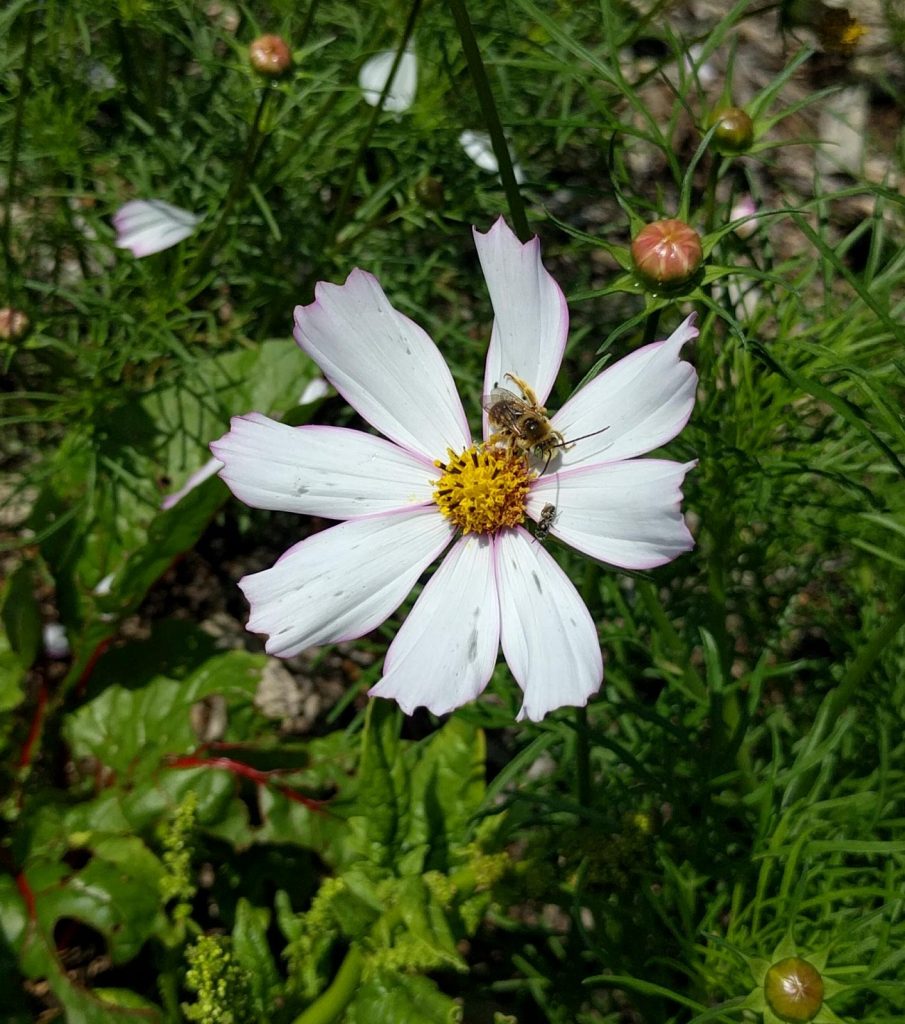
Attracting specific bees
Since my primary goal is to increase avocado pollination, I wanted the bulk of my Bee Garden plants to be those which are most attractive to the kinds of bees that are known to also visit avocado flowers.
Gordon Frankie has observed that frequent visitors, and so potential pollinators, of avocado flowers include species of Ceratina, Halictus, and Andrena. And in California Bees and Blooms there is a section profiling plants that attract bees, including which types of bees are the most frequent visitors. So, for example, I bought three plants of our native coast sunflowers (Encelia californica) because it is written that Halictus species, also called Sweat Bees, frequently visit them.

Arranging plants
Why did I buy three plants? A lesson I’ve learned well from past flower plantings is that bees are more attracted to larger plantings of a single type of flower, “patches” it is called in rule of thumb number five in California Bees and Blooms. I’ve seen this play out in my yard many times. So in developing my new Bee Garden I aimed to plant patches of at least three or four feet wide, and it has been effective.
For example, I’ve got multiple plantings of tansy phacelia around my yard today. This plant’s flowers are extremely attractive to multiple species of bees, but wherever the planting is a patch of about five feet there are many more visitors compared to where I just have a single plant growing.

Very attractive to bees — especially honey bees and Ceratina species (Small Carpenter Bees) — this plant is nevertheless one to add to your Bee Garden with caution. It has mildly stinging hairs on its stems and leaves so it’s best planted where you or your children are unlikely to brush up against it.
A mistake I made is planting both this tansy phacelia and another type of phacelia (caterpillar, or cicutaria) next to paths. It has been a chore to keep myself and others from being irritated by accidentally touching the plant. But it’s so incredibly attractive to bees that I can’t get myself to remove it.
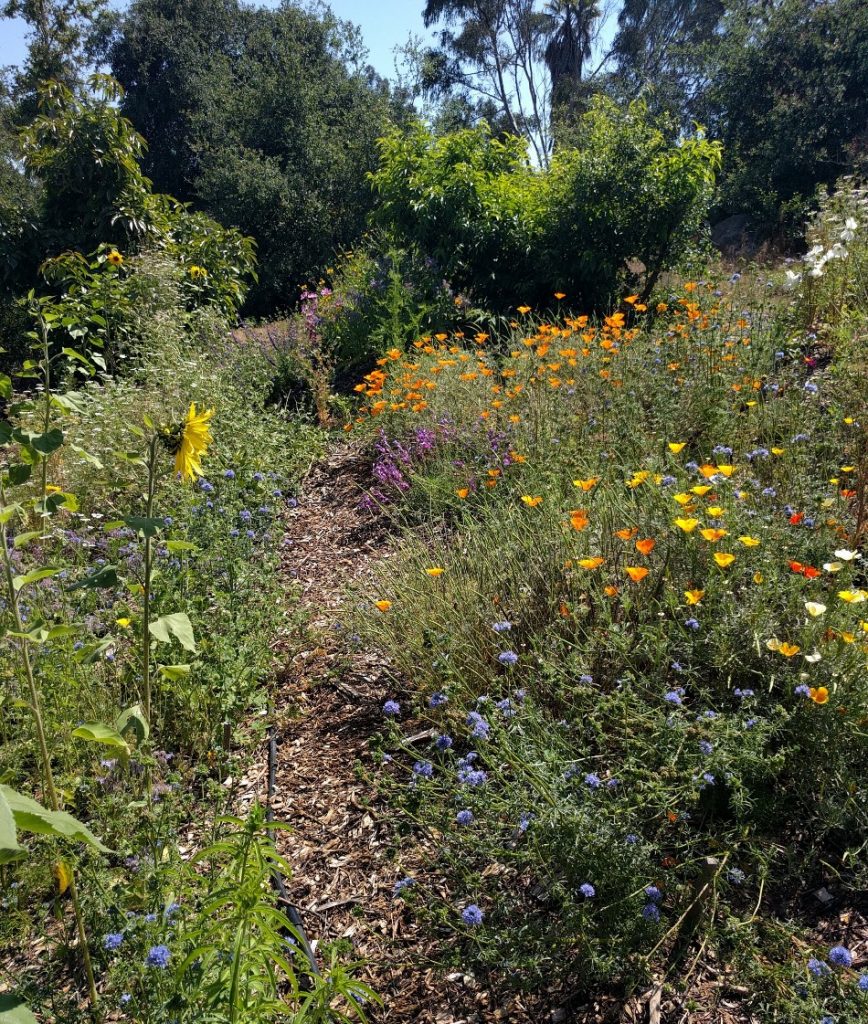
But hey, I brought the bees! I did it. It worked! You should take a walk through this Bee Garden on a sunny afternoon these days. What was once a bare hill is now abuzz with pollinating life. Let me show you:
Achieve my pollination goal?
But remember, I wasn’t growing these flowers just to bring the bees. I wanted the bees to do some work for me. Have they provided the pollination enhancement that I hoped for? It’s just too early to say.
Actually, I didn’t even expect to attract many bees to the Bee Garden in this first year because I thought it would take longer for the plants to fill in and bloom heavily. And it will only be next spring when the Bee Garden has had a year of drawing and feeding bees and increasing the populations that I should be able to notice an increase in visitors to the avocado bloom of spring 2020.
Bee Garden brings unexpected benefits
As I mentioned earlier, my enjoyment of the color that the Bee Garden has brought to my yard was unexpected. On Mother’s Day, my mom and grandma visited and both made comments of approval about my addition of these flowers. These weren’t their words, but I could tell they thought this part of the yard had been an eyesore until now. It was nice to win their praise.
Also unexpected has been the diversity of non-bees that have arrived to feed in the Bee Garden. I’ve seen numerous butterflies, wasps, beetles, flies, and hummingbirds visit. And the various syrphid flies have been astonishing.

Looking forward into summer
I have watered the Bee Garden twice. Once on April 14, and the second time only a few days ago on June 5. I water with an oscillating sprinkler, and add just over an inch each time. I’m curious to see how much water will be necessary through summer in order to continue good bloom.
My plant choices have been geared toward low-water and native plants so I’m hoping to get away with watering only about once per month in July, August, and September, but I’m open to watering as much as twice per month if necessary.
Hopefully, after this next winter, the plants will grow and bloom well without any further irrigation. I have other bee plants in my yard which grow splendidly without irrigation.
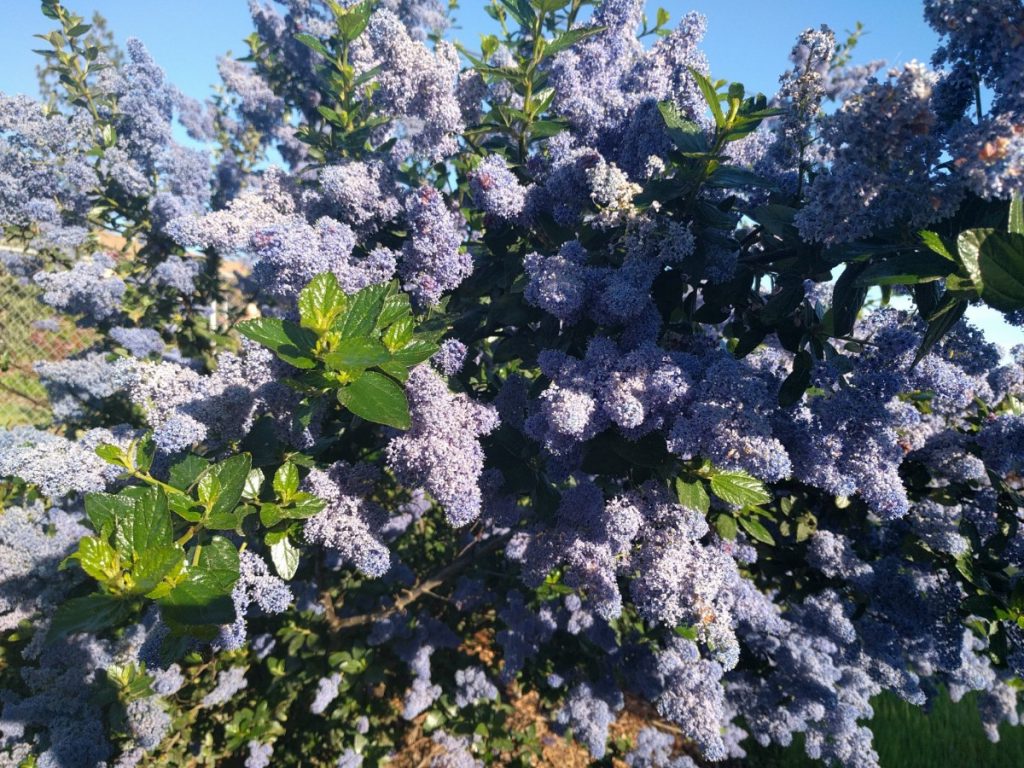
Start a Bee Garden today?
Want to get a Bee Garden going now? It’s definitely easiest to start when I did in the late fall as the first rains fall, but it’s certainly possible to start some plants that bees love any day of the year.
If I were starting a Bee Garden today or through summer or early fall, I would choose just a couple of flowers which have proven very attractive to a variety of bees in my yard during past summers and falls. I would plant cosmos (bipinnatus), sunflowers (‘Lemon Queen’ I’ve found to be a good one for native bees), oregano, and even cilantro (even though it won’t flower for as long in summer).
You might also like to refer to the list of best bee plants for California put together by Gordon Frankie’s U.C. Berkeley Urban Bee Lab here.
Just remember that you need not go big with a full Bee Garden as I have finally done this year. A single patch of a single kind of plant that’s about as wide as your arms can draw a lot of bees. One six-pack of cilantro that you allow to flower will do it. And do cut leaves for salsa as it bolts.
You might also like to read my posts:

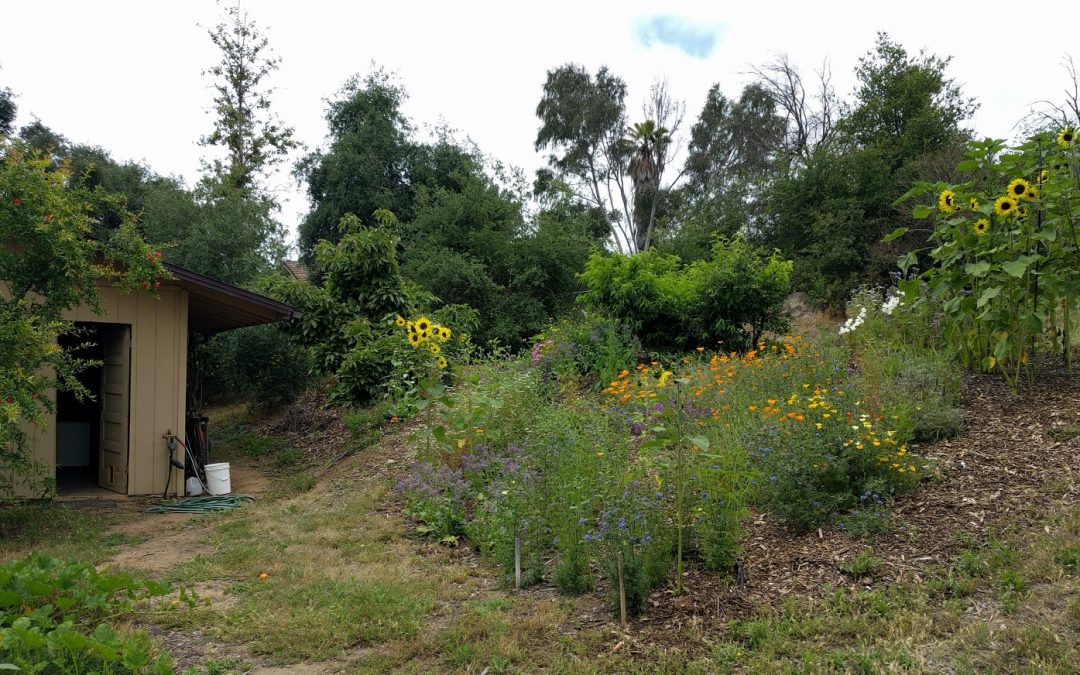


Hi Greg! Great idea. I have 1,800sf slope that we’re working to turn into a “pollinator patch”… and provide stability. Mostly CA native plants with “weed” in their names, eg Deer weed. The real puzzle is to me is how much to water.
Hi Robert,
Perfect idea for that slope. My perspective on natives is that if you choose them right — that is, if they’re actually native to your neighborhood and not some far off corner of California that has a totally different climate and soils — then you should not need to water them beyond their first summer, at the most. In fact, I have started to think that watering natives is the biggest killer or life-shortener of them around here.
I’ve planted some natives that I’ve never watered after planting, and I’ve planted others that I’ve watered once per month during their first summer. I’ve always planted my natives in the late fall or winter or very early spring.
I think the key is having a tolerance for them looking a bit tired at the end of summer. It doesn’t necessarily mean they need your irrigation. And I’ve never had a native die from lack of water, even during all those drought winters.
One factor that I have noticed affecting the growth and apparent water needs of my natives is the depth of good soil. Where I’ve planted them in undisturbed areas, they’ve thrived. But where I’ve planted them in soil that has had its top scraped off because of long ago grading, they’ve usually grown more slowly. If your slope has been scraped down to subsoil, then you might have to do some extra mulching and watering in the first couple years.
In general though, I think of natives as needing the watering of their original climate. If that original climate is your neighborhood, then that means whatever the rainfall is. You just give them a little irrigation perhaps through the first summer if you’ve put in transplants because that is not how they would grow naturally.
Very good read. I like the logic and analysis you used for plant selection.
We are getting settled in on two acres on Hawaii’s Big Island and are working at getting the gardens “in order”. I will use the Bee Garden concept…especially near the avocado tree.
Mahalo!
Hi Grant,
What a project you have ahead! That seems like a great place to grow.
Greg, as usual I thoroughly enjoyed your letter on bee gardens but the reason for this post is to thank you. I wrote a couple of weeks ago about my Meyer lemon not having many leaves. As bad as it hurt I took your advice and removed most of the new fruit (I cheated and left about 6 lemons on ?). Already my Trent has a ton of new leaves and putting off little branches. Thank you, thank you, thank you so much. nelda
Thank you for your kind comment here, Nelda. I love hearing this update.
hmm I thought I left a post lamenting about how fewer bees it seems we have this year… until I found this!!!
https://youtu.be/uhFrKfB7AZc
That’s fantastic! You’re going to get so much fruit next year! I have that same irrigation valve cover . . . and I just might put it in a place that appeals to a honeybee swarm to see what happens.
it’s perfect for them, the two handle openings on each side allows for a good entrance and exit. I think they are building up the colony, they aren’t really flying around my blooms but are just concentrating around the hive – hence my initial lament about not seeing as many bees this year but at least I know they are around!
Great post! There is a wholesale nursery (Moosa Creek) in Valley Center that specializes in California natives. You can pre-order and have them delievered for purchase at certain retail nurseries around the county. But even better, on their website they have an extensive database on the plants they sell with a ton of information about cultural requirements (including which plants never to water), and what they can be used for, such as attracting bees and native pollinators. Occassionally, they have seminars and on-site plant sales. Another great resource for information on California natives is the Theodore Payne Foundation. They have a database, plant guides, classes and nursery (in Sun Valley). A little far to buy plants, but they also sell seeds for plants you’ll never find in a nursery, like deerweed and wooly blue curls.
Hi Jane,
Thanks for these comments! Many of the native plants that I’ve bought were grown by Moosa Creek. They grow great plants. Here’s a link to their website: Moosa Creek Nursery.
I hadn’t known that Theodore Payne Foundation sold so many different seeds. I’m definitely going to get some to sow this coming winter. Here is the seeds page of the Theodore Payne Foundation.
Hey Greg, any update on your bee garden? Here in NorCal we are getting our first steady run of rain days and I’m putting in a bag of Burpee Pollinator seeds. Curious to know how yours is doing after a few years in the ground.
Hi Greg,
I have an area of my yard that has had heavy weeds for several years. It’s near my raised beds and fruit trees. I would like to create a bee or pollinator garden. When you say you removed the weeds, did you simply pull them? Any suggestions for preventing future seeds from sprouting? Would it help to put a layer of top soil or mulch around plants after planting?
Thanks for all the insight as usual.
Hi Andie,
Good question. What I did was cut all of the weeds at ground level and remove them so that I took their seeds away. Then I spread a wood-chip mulch throughout the area. Occasionally over the past few years I have had to pull a few weeds and spread a little more mulch in some bare spots, but otherwise that has eliminated weeds from the area. One other important thing is to totally fill the area with flowering plants. The weeds especially love to fill in empty spots.
After watching how much the bees enjoy broccoli I intentionally left to flower, and after making some wild bee nests out of a bundle of dried Agapanthus (Lily of the Nile) stems, the next step is more food for them. I am germinating California Bush Sunflower and just ordered the Save the Bees flower mix you mentioned. Maybe I can save some bees but I have selfish reasons, fun and pollination.
Glad I found your blog — we are in the high desert outside of LA, and looking to build a beautiful garden that also functions as a pollinator garden that can survive our intense heat and iffy soil. Rather large backyard, currently all dirt and a just a few plants around the pergola we built last year. Late start this spring season due to family events, but planning for the fall planting. Last year we put in some pumpkins and sunflowers just for some green, and loved all of the pollinators those plants attracted. We are going to also add a bee house and water station as part of our upcoming plans. Looking forward to reading your blog in depth — thanks for sharing